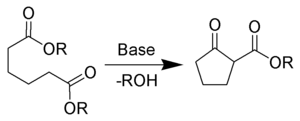Condensation reaction

A condensation reaction, is a chemical reaction in which two molecules or moieties, often functional groups, combine to form a larger molecule, together with the loss of a small molecule.[1] Possible small molecules that are lost include water, hydrogen chloride, methanol, or acetic acid, but most commonly in a biological reaction it is water.
When two separate molecules react, the condensation is termed intermolecular. A simple example is the condensation of two amino acids to form the peptide bond characteristic of proteins. This reaction example is the opposite of hydrolysis, which splits a chemical entity into two parts through the action of the polar water molecule, which itself splits into hydroxide and hydrogen ions. Hence energy is required to form chemical bonds via condensation.
If the union is between atoms or groups of the same molecule, the reaction is termed intramolecular condensation, and in many cases leads to ring formation. An example is the Dieckmann condensation, in which the two ester groups of a single diester molecule react with each other to lose a small alcohol molecule and form a β-ketoester product.

Mechanism
Many condensation reactions follow a nucleophilic acyl substitution or an aldol condensation reaction mechanism. Other condensations, such as the acyloin condensation are triggered by radical or single electron transfer conditions.
Condensation reactions in polymer chemistry
In one type of polymerization reaction, a series of condensation steps take place whereby monomers or monomer chains add to each other to form longer chains called polymers. This is termed 'condensation polymerization' or 'step-growth polymerization', and occurs for example in the synthesis of polyesters or nylons. It may be either a homopolymerization of a single monomer A-B with two different end groups that condense or a copolymerization of two co-monomers A-A and B-B. Small molecules are usually liberated in these condensation steps, in contrast to polyaddition reactions with no liberation of small molecules.
In general, condensation polymers form more slowly than addition polymers, often requiring heat. They are generally lower in molecular weight. Monomers are consumed early in the reaction; the terminal functional groups remain active throughout and short chains combine to form longer chains. A high conversion rate is required to achieve high molecular weights as per Carothers' equation.
Bifunctional monomers lead to linear chains, and therefore thermoplastic polymers, but, when the monomer functionality exceeds two, the product is a branched chain that may yield a thermoset polymer.
Applications
This type of reaction is used as a basis for the making of many important polymers, for example: nylon, polyester, and other condensation polymers and various epoxies. It is also the basis for the laboratory formation of silicates and polyphosphates. The reactions that form acid anhydrides from their constituent acids are typically condensation reactions.
Many biological transformations are condensation reactions. Polypeptide synthesis, polyketide synthesis, terpene syntheses, phosphorylation, and glycosylations are a few examples of this type of reaction. A large number of such reactions are used in synthetic organic chemistry. Other examples include:
- Acyloin condensation
- Aldol condensation
- Benzoin condensation (this is not technically a condensation, but is called so for historical reasons)[1]
- Claisen condensation
- Claisen–Schmidt condensation
- Darzens condensation (glycidic ester condensation)
- Dieckmann condensation
- Guareschi–Thorpe condensation
- Knoevenagel condensation
- Michael condensation
- Pechmann condensation
- Rap–Stoermer condensation
- Self-condensation or symmetrical aldol condensation
- Ziegler condensation
See also
- Anabolism
- Hydrolysis, the opposite of a condensation reaction
- Condensed tannins
References
- 1 2 IUPAC, Compendium of Chemical Terminology, 2nd ed. (the "Gold Book") (1997). Online corrected version: (1994) "Condensation Reaction".